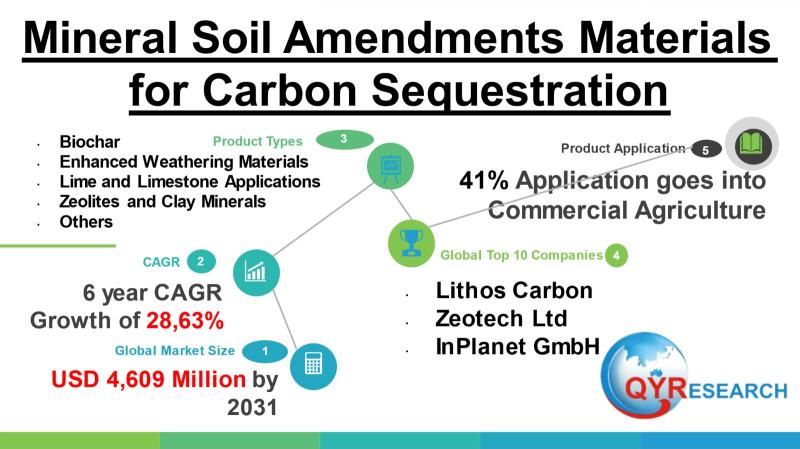Press release
Mineral Soil Amendments Materials for Carbon Sequestration Market to Reach 28,63% CAGR by 2031 Top 10 Company Globally
Mineral soil amendments materials such as biochar, crushed silicate rock (enhanced rock weathering, ERW), lime and dolomite, olivine/basalt mineral fines and other mineral-rich products are being deployed at increasing scale to improve soil health and to lock atmospheric CO2 into soil and carbonate pools for long periods. These amendments work through different mechanisms: biochar increases stable soil organic carbon and improves soil structure; crushed silicate rocks react with CO2 and form bicarbonate or carbonate species (enhanced weathering); liming neutralizes acidity and can change soil carbon dynamics; and mineral-rich amendments supply nutrients that stimulate root growth and microbial activity, indirectly increasing soil carbon inputs.The global Mineral Soil Amendments Materials for Carbon Sequestration market in 2024 estimated between USD 726 million, forecast to reach USD 4,609 million by 2031 at around 28,63% CAGR. Growth is driven primarily by the expansion of voluntary and compliance carbon markets, which create direct financial incentives for farmers and project developers to adopt amendments like biochar and enhanced rock weathering. In addition, government-backed soil health initiatives, rising corporate net-zero commitments, and improved monitoring technologies are accelerating adoption globally, particularly in regions with degraded soils and high agricultural intensity.
Latest Trends and Technological Developments
Several high-visibility developments in 20242025 underline the sectors rapid evolution. On December 2024, major corporate buyers and carbon-removal intermediaries backed enhanced rock weathering deals, signaling commercial interest in spreading crushed basalt at farm scale and underwriting removal credits tied to ERW deployments. This deal cluster was widely covered in the press as an early large-scale commercial commitment to ERW. On April 2025, Mati Carbon an organization focused on deploying enhanced rock weathering with smallholder farmers was announced as an XPrize Carbon Removal winner and publicized plans to scale ERW activities in India and beyond, highlighting both philanthropic and competitive funding flows into mineral amendment approaches that are farmer-facing. In February 2025 a comprehensive Nature analysis modeled the potential of agricultural enhanced weathering in the United States and concluded that, deployed at scale, ERW could be a meaningful carbon dioxide removal pathway, while also identifying key supply, cost and MRV (monitoring, reporting, verification) challenges that remain. Parallel academic work in 2024 showed that biochar and mineral-rich biochars can increase soil carbon storage and may further sorb atmospheric CO2 when applied to soils, strengthening the scientific case for mixed mineral-organic amendment strategies. These studies and commercial deals together demonstrate that 2024-2025 has been a turning point from laboratory and small-plot trials toward commercialization and corporate procurement of mineral-based soil carbon removal.
Asia is both a major opportunity and a site of active innovation for mineral soil amendments. The regions extensive agricultural area, large smallholder farmer populations, and urgent land restoration needs make it a prime target for biochar, olivine/basalt ERW pilots and nutrient-rich mineral amendments. China, India and Japan are notable for domestic R&D, pilot programs and early industry actors, while China in particular has significant production capacity for rock dust and mineral materials and a rapidly developing biochar industry tied to agricultural waste streams. Policy levers such as agro-ecological subsidies, soil health programs, and the inclusion of soil carbon in national strategies are emerging across Asian governments, which accelerates both adoption and local manufacturing of amendment products. Several Asia-focused initiatives are testing farmer payment models, bundling yield benefits with carbon payments to improve farmer economics; early evidence and pilots from the subcontinent and East Asia suggest that when amendments also increase yields or nutrient availability, farmer uptake rises markedly. These regional dynamics are referenced in market analyses that highlight Asia-Pacific as a high-growth region for mineral amendment solutions.
Get Full PDF Sample Copy of Report: (Including Full TOC, List of Tables & Figures, Chart)
https://www.qyresearch.com/sample/4803679
Mineral Soil Amendments Materials for Carbon Sequestration by Type:
Pharma Grade
Cosmetic Grade
Industrial Grade
Industrial Grade
Others
Mineral Soil Amendments Materials for Carbon Sequestration by Application:
Pharmaceutical
Pharmaceutical
Cosmetic
Industrial Lubricant
Others
Global Top 10 Key Companies in the Mineral Soil Amendments Materials for Carbon Sequestration Market
Unilever PLC
Sonneborn LLC
South Africa Coal, Oil and Gas Corporation Ltd.
Navid Noor Co.
Kerax Limited
Spectrum Chemical Mfg. Corp.
Taurus Petroleums Pvt. Ltd.
Qingdao Fengchen Technology and Trade Co., Ltd.(青岛丰臣科技贸易有限公司)
Unicorn Petroleum Industries Pvt. Ltd.
PT. Kirana Mitraabadi
Regional Insights
Southeast Asia is an important and fast-evolving market for mineral soil amendments for two reasons: first, the region has large tracts of degraded soils and peatlands where amendments (biochar and specially designed mineral mixes) can improve productivity and provide co-benefits; second, it is a focus area for several ERW and biochar projects aiming to generate verifiable carbon removals while delivering agronomic co-benefits. Indonesia, the Philippines, Thailand and Vietnam have active pilots or early commercial initiatives that combine restoration, soil amendment and carbon finance Indonesias peat restoration and rewetting programs, for example, are being complemented in some pilots by amendment approaches aimed at stabilizing soils and reducing emissions. Project developers operating in Southeast Asia often emphasize co-benefits to livelihoods and yield, because smallholder economic incentives are critical to scale in the region. Financing flows from voluntary carbon markets, combined with international climate finance and corporate procurement, are increasingly targeting Southeast Asian pilots, making the region a likely growth frontier over the next five to ten years.
Mineral Soil Amendments Materials for Carbon Sequestration by Region:
North America
Europe
China
Japan
India
South East Asia
Scaling mineral soil amendments for climate mitigation faces several structural challenges. The first is MRV: proving how much durable carbon removal an amendment delivers especially for approaches like ERW where a portion of carbon may be exported as bicarbonate to water bodies requires robust, standardized measurement frameworks, long-term monitoring and conservative accounting, all of which add cost and slow crediting. The second challenge is logistics and cost: sourcing, grinding and spreading rock fines at the scales required for gigaton-level impact requires quarrying, grinding energy and transport systems that can dominate costs and emissions if not carefully optimized. Third, regulatory and social license risks exist: quarrying and spreading minerals at scale raise environmental permitting, dust and community consent issues, and local agronomic responses may vary by soil type and cropping system; this heterogeneity complicates simple, wide-scale rollouts. Finally, adoption barriers persist at the farm level farmers need clear, short-term agronomic or income signals (yield, soil fertility or a reliable carbon payment) to change practices rather than waiting for long-term climate benefits. These challenges appear in both the academic literature and market analyst reports as central constraints to scaling.
Companies and project developers entering this space are pursuing several strategies to de-risk scale-up: integrating value chains (linking quarries, grinders, transport and local applicators), co-packaging amendments with yield-positive agronomy packages so farmers see immediate benefits, and partnering with carbon registries to develop conservative, science-based MRV protocols. Some firms are vertically integrating feedstock supply (for example, owning basalt/olivine sources) while others focus on the MRV and credit-generation side to capture higher margins. On the policy side, public-private demonstration projects and government-supported trials can accelerate farmer learning and unlock subsidies that reduce up-front costs. Investors and corporates are also using purchase agreements (forward procurement of removal tons) to provide demand visibility that lowers project financing costs; high-profile corporate purchases reported in late 2024 and early 2025 show how demand-side commitments can accelerate supply-chain investments.
Product Models
Mineral soil amendments play a critical role in improving soil health while enhancing long-term carbon sequestration potential. These materials, ranging from carbon-rich biochar to mineral-based enhanced weathering agents, are used to stabilize organic matter, increase nutrient availability, and lock atmospheric carbon into stable soil forms.
Biochar A stable, carbon-rich material produced by pyrolyzing biomass in low-oxygen conditions, used to enhance soil fertility and lock carbon in the ground for centuries. Notable products include:
CoolTerra® by Cool Planet: Biochar designed for soil moisture retention and microbial habitat improvement.
Biochar Now by Biochar Now LLC: Kiln-produced biochar for long-term carbon storage in degraded soils.
ECO-CHAR® by Eco Char (Pty) Ltd: Livestock manure-based biochar rich in organic carbon and minerals.
CarboChar by Carbon Gold: Biochar enriched with beneficial microbes for regenerative farming.
AgriChar by Pacific Biochar: Large-scale agricultural biochar designed for nutrient cycling and carbon locking.
Enhanced Weathering Materials Finely ground silicate or carbonate rocks (like basalt) spread on soils to naturally react with CO2 and store it as stable minerals. Examples include:
Basalt Rock Dust by Rock Dust Local: Finely ground basalt for mineral weathering and carbon capture.
RemineralizeTM Basalt by Gaia Green: Basalt powder to replenish minerals and enhance soil CO2 drawdown.
Glacial Rock Dust by Gaia Green Organics: Slow-release mineral dust for nutrient and carbon balance.
MetaBasalt by Enhanced Weathering Corp: High-silicate basalt engineered for rapid CO2 mineralization.
Silicate Solutions by Leverhulme Centre: Research-grade silicate minerals for carbon sequestration trials.
Lime and Limestone Applications Calcium carbonate-based materials added to soil to adjust pH and improve nutrient availability while capturing and storing atmospheric CO2. Products examples include:
CalCarb® by Mississippi Lime Company: Agricultural lime for pH balance and CO2 storage as carbonate.
Hi-Cal Lime by Graymont: High-calcium lime for soil health and carbon stabilization.
Dolopril® by Lhoist: Pelletized dolomitic lime for easy soil application.
Calpril® by Columbia River Carbonates: Fine limestone prills for agricultural use.
AgLime by Carmeuse: Crushed limestone to neutralize soil acidity and bind carbon.
Zeolites and Clay Minerals Naturally occurring or synthetic aluminosilicate minerals that improve soil structure, increase water retention, and trap carbon in stable mineral forms. Products examples include:
Clinoptilolite Zeolite by Zeotech Corp: Natural zeolite for nutrient retention and CO2 adsorption.
AgriZeoliteTM by Zeolite Australia: Soil conditioner improving CEC and carbon stability.
ZeoSand: Zeolite-based sand for water filtration and carbon binding in soils.
BioZeoTM by BioZeo Technologies: Zeolite infused with biochar for dual carbon storage.
TerraZeo by Terra Firma Minerals: Agricultural zeolite for nutrient cycling and pH balance.
Mineral soil amendments for carbon sequestration are moving from research and pilots toward commercialization, driven by improvements in scientific understanding, growing corporate demand for verified removals, and supportive pilots and policies across Asia and Southeast Asia. While the technical potential is substantial academic work on ERW and biochar suggests meaningful removal and soil health co-benefits the sectors growth depends critically on solving MRV challenges, optimizing logistics and ensuring farmer economics. Market estimates for 2024 place the focused mineral-amendment carbon market in the low-hundreds of millions of USD with sustained high-single-digit CAGRs expected as the industry professionalizes; broader soil amendment markets that include non-carbon use cases are larger, in the billions. Strategic collaboration among suppliers, agronomists, carbon registries and buyers will be essential to scale impact responsibly.
Investor Analysis
Investors should view mineral soil amendments as a hybrid opportunity that blends agricultural inputs, environmental services (carbon removal) and infrastructure logistics. What investors can buy into: early-stage ERW and biochar project developers with credible MRV pipelines, grinding and logistics assets that lower per-ton costs, and platform businesses that bundle amendments with agronomy and carbon credit issuance. How investors can participate: equity investments in specialized producers or integrators, project finance for large regional pilots (to prove per-ton costs and MRV), or offtake agreements that secure future removal tons and provide project cashflows. Why it matters: the sector offers alignment with ESG mandates and exposure to growing voluntary and regulated carbon markets, while delivering agricultural co-benefits that can aid adoption. That said, investors must underwrite technical and regulatory risk, insist on conservative MRV and permanence assumptions, and prefer models that reduce transport-intensive supply chains or locate grinding near source quarries to control embodied emissions and cost. High-quality investments will emphasize transparent scientific backing, robust field trials, strong farmer economics and clear pathways to credit issuing.
Request for Pre-Order Enquiry On This Report
https://www.qyresearch.com/customize/4803679
5 Reasons to Buy This Report
You will obtain a consolidated view of the mineral soil amendments market size and growth drivers, with a focus on carbon sequestration applications and the relevant market signals in 20242031.
The report synthesizes recent scientific and commercial developments (biochar studies, ERW modeling and corporate procurement deals) that are directly shaping investment and project design choices.
Regional analysis of Asia and Southeast Asia highlights where pilots, policy support and agricultural need align critical intelligence for geographically targeted investments.
Strategic and operational risks (MRV, logistics, social license) are explained alongside practical mitigation strategies that investors and project developers can apply.
The report links market forecasts, real-world project case studies and corporate purchase activity to help buyers assess commercial viability and timing for scaling.
5 Key Questions Answered
What was the estimated market size for mineral soil amendments focused on carbon sequestration in 2024 and what are the underlying demand drivers?
Which technical approaches (biochar, enhanced rock weathering, lime/alkaline amendments) show the most promise for durable carbon removal, and what is the evidence base?
How are Asia and Southeast Asia positioned in terms of supply, pilot activity and policy support, and where should investors prioritize deployment?
What are the main MRV, logistical and social challenges to scale, and what mitigation strategies are emerging in the market?
Which business models (materials supply, integrated service providers, MRV/credit platforms) offer the most attractive risk/reward for investors at present?
Chapter Outline
Chapter 1: Introduces the report scope of the report, executive summary of different market segments (by region, product type, application, etc), including the market size of each market segment, future development potential, and so on. It offers a high-level view of the current state of the market and its likely evolution in the short to mid-term, and long term.
Chapter 2: key insights, key emerging trends, etc.
Chapter 3: Manufacturers competitive analysis, detailed analysis of the product manufacturers competitive landscape, price, sales and revenue market share, latest development plan, merger, and acquisition information, etc.
Chapter 4: Provides profiles of key players, introducing the basic situation of the main companies in the market in detail, including product sales, revenue, price, gross margin, product introduction, recent development, etc.
Chapter 5 & 6: Sales, revenue of the product in regional level and country level. It provides a quantitative analysis of the market size and development potential of each region and its main countries and introduces the market development, future development prospects, market space, and market size of each country in the world.
Chapter 7: Provides the analysis of various market segments by Type, covering the market size and development potential of each market segment, to help readers find the blue ocean market in different market segments.
Chapter 8: Provides the analysis of various market segments by Application, covering the market size and development potential of each market segment, to help readers find the blue ocean market in different downstream markets.
Chapter 9: Analysis of industrial chain, including the upstream and downstream of the industry.
Chapter 10: The main points and conclusions of the report.
Tel: +1 626 2952 442 (US) ; +86-1082945717 (China)
+62 896 3769 3166 (Whatsapp)
Email: willyanto@qyresearch.com; global@qyresearch.com
Website: www.qyresearch.com
QY Research has established close partnerships with over 71,000 global leading players. With more than 20,000 industry experts worldwide, we maintain a strong global network to efficiently gather insights and raw data.
Our 36-step verification system ensures the reliability and quality of our data. With over 2 million reports, we have become the world's largest market report vendor. Our global database spans more than 2,000 sources and covers data from most countries, including import and export details.
We have partners in over 160 countries, providing comprehensive coverage of both sales and research networks. A 90% client return rate and long-term cooperation with key partners demonstrate the high level of service and quality QY Research delivers.
More than 30 IPOs and over 5,000 global media outlets and major corporations have used our data, solidifying QY Research as a global leader in data supply. We are committed to delivering services that exceed both client and societal expectations.
This release was published on openPR.
Permanent link to this press release:
Copy
Please set a link in the press area of your homepage to this press release on openPR. openPR disclaims liability for any content contained in this release.
You can edit or delete your press release Mineral Soil Amendments Materials for Carbon Sequestration Market to Reach 28,63% CAGR by 2031 Top 10 Company Globally here
News-ID: 4140853 • Views: …
More Releases from QY Research
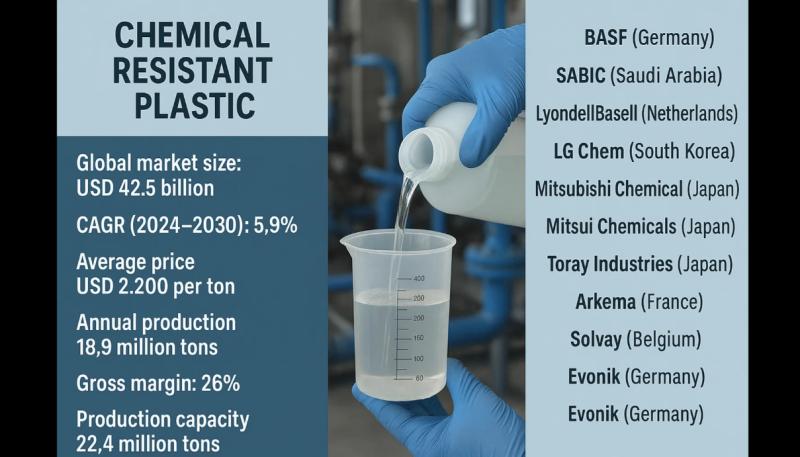
How Chemical-Resistant Plastics Transformed Industrial Reliability
Bercen Chemicals, a chemical blending facility in Louisiana suffered recurring equipment failures in its transfer lines, pump housings, and storage tank fittings due to aggressive exposure to acids, alkalis, and organic solvents. Metal components corroded rapidly, while standard engineering plastics such as PVC and ABS became brittle, swollen, or cracked under prolonged chemical attack. These failures caused leaks, safety risks, and unplanned shutdowns that disrupted production and increased maintenance costs.
To…
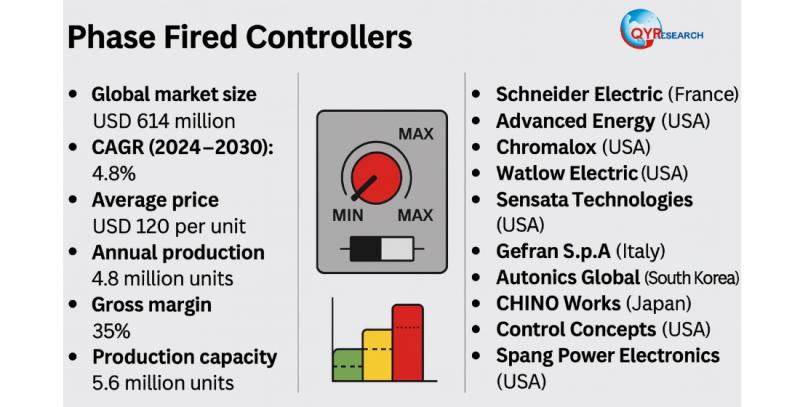
Global and U.S. Phase Fired Controllers (PFCs) Market Report, Published by QY Re …
A heat-treatment furnace manufacturer in Italy struggled with unstable temperature control and excessive energy consumption in its industrial ovens used for alloy hardening. Traditional on/off contactor-based heating caused large temperature swings, poor reproducibility, and frequent thermal overshoot, leading to inconsistent metallurgical results and higher rejection rates. The sudden switching also introduced high inrush currents that stressed heating elements and increased maintenance downtime.
To solve these issues, the company integrated Phase Fired…
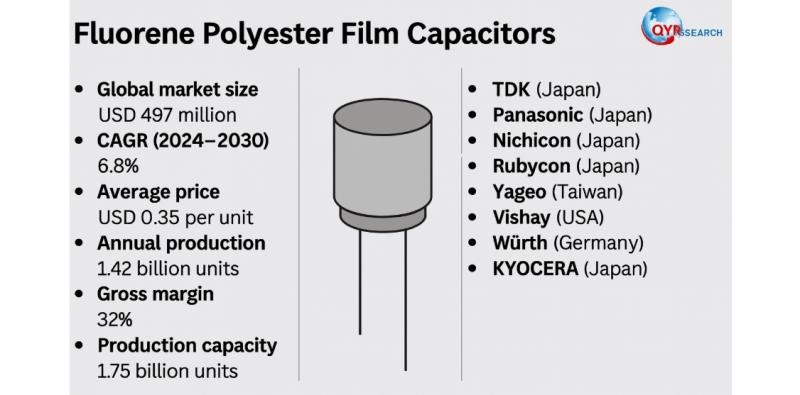
Global and U.S. Fluorene Polyester Film Capacitors Market Report, Published by Q …
A solar inverter manufacturer in Germany faced recurring failures in its DC-link capacitors due to high ripple current, thermal stress, and long-term voltage degradation. The polypropylene (PP) film capacitors used in the design began to exhibit dielectric fatigue and capacitance drift when exposed to elevated temperatures inside compact inverter housings. These failures reduced inverter efficiency, caused thermal shutdowns, and increased warranty claims-especially during peak summer operation.
To solve the issue, the…
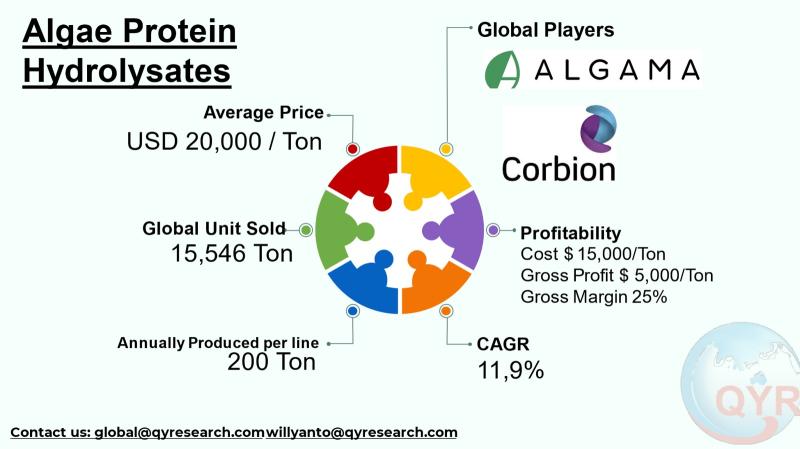
Premium Proteins at Scale: The Technologies, Trends, and Players Transforming th …
Algae protein hydrolysates are specialty protein ingredients produced by breaking down algae-derived proteins into shorter peptides and amino acids through enzymatic, chemical, or thermal hydrolysis processes. These ingredients are prized for their high digestibility, concentrated amino acid profiles, and functional properties that suit nutraceuticals, specialized foods, animal feed, cosmetics and agricultural biostimulants. Producers and buyers view algae protein hydrolysates both as a sustainable alternative to conventional protein hydrolysates and as…
More Releases for Asia
Asia Private Equity Firm, Asia Private Equity Management, Asia Private Equity Se …
The private equity market in China has been rapidly growing in recent years. Private equity (PE) refers to the purchase of shares in a company that are not publicly traded on a stock exchange. PE firms typically target companies that are undervalued or in need of capital for growth, and aim to improve the company's operations and financial performance before selling it at a higher value.
https://boomingfaucet.com/
Asia Private Equity Consulting
E-mail:nolan@pandacuads.com
In China,…
South East Asia Business Jet Market And Top Key Players are Asia Corporate Jet, …
By 2022, the South East Asia Business Jet Markets estimated to reach US$ XX Mn, up from US$ XX Mn in 2016, growing at a CAGR of XX% during the forecast period. The Global Business Jet Market, currently at 21 million USD, contributes the highest share in the market and is poised to grow at the fastest rate in the future. The three broad categories of business jets are Small,…
LIXIL Asia Presents Asia Pacific Property Awards
Through its power brands GROHE and American Standard, LIXIL Asia signs a three-year deal to become the Headline Sponsor of the Asia Pacific Property Awards from 2019 until 2022.
23rd January 2019: The International Property Awards, first established in 1993, are open to residential and commercial property professionals from around the globe. They celebrate the highest levels of achievement by companies operating within the architecture, interior design, real estate and property…
PEOPLEWAVE WINS ASIA TECH PODCAST PITCHDECK ASIA 2019 AWARDS
15 January 2019, Singapore – Peoplewave, Asia’s leading data-driven HR technology company, won the Asia Tech Podcast (ATP) Pitchdeck Asia 2019 Awards, being awarded “Startup Most Likely to Succeed in 2019".
The 2019 Pitchdeck Asia Awards is an opportunity for the Asian Startup Ecosystem to shine a spotlight on some of its best startups. The awards were decided by a public vote. More than 7,200 votes were cast by registered LinkedIn…
Undersea Defence Technology Asia, UDT Asia 2011
Latest Military Diving Technologies featured in UDT Asia
Equipping Asia’s navies with the latest diving technology for asymmetric warfare and
operations
SINGAPORE, 17 October 2011 - Naval diving and underwater special operations is a field that is
seeing increased attention and investment amongst navies in Asia. Units such as the Indonesian Navy‟s KOPASKA, the Republic of Singapore Navy‟s Naval Diving Unit (NDU), the Royal Malaysian Navy‟s PASKAL are increasingly utilising specialised equipment for conducting…
Asia Diligence – Specialist Investigative Due Diligence for Asia & Beyond
Asia Diligence today announced the opening of its European Customer Services office in the United Kingdom. The office is to be managed by Steve Fowler and will focus on providing services to Asia Diligence’s European customers. Asia Diligence is also planning to open a US office in the near future, which will provide customer service to its US and North American clients.
Asked to comment on the move, Luke Palmer, the…
